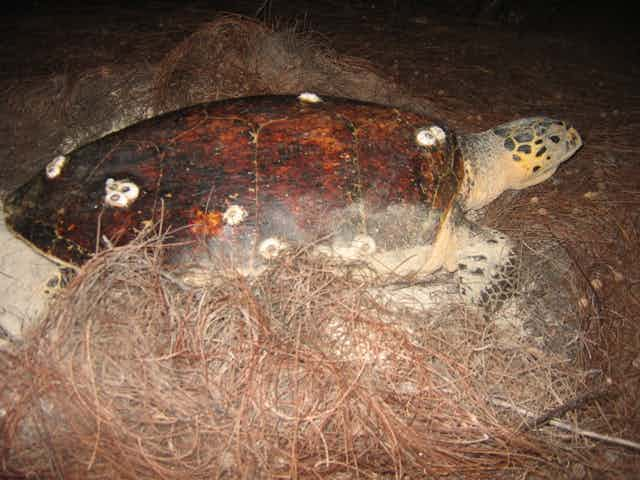The Hawksbill Turtle (Eretmochelys imbricata) is one of the seven species of marine turtles and one of six in the family Cheloniidae. It is easily distinguished from other turtle species by its beak-like mouth and overlapping scales, or scutes. Harvested for centuries for their exquisitely patterned shell, some hawksbill populations now face an uncertain future.
Hawksbills, while widely distributed throughout the world’s tropical oceans, prefer warm, shallow waters and lagoons. Although hawksbills are most commonly associated with coral reef systems, they sometimes nest in mangrove-fringed islands or beaches. Like other marine turtles species, hawksbills are migratory and can swim long distances between breeding and feeding grounds.
Hawksbills spend most of their lives at sea, only coming ashore to lay eggs. Little is known about turtles’ habitat use or behaviour during the “lost years” between hatching and their initial appearance at foraging grounds.
Much of what we know about the species comes from studies on nesting turtles and a few long-term foraging area studies. Sponges and algae make up the bulk of the hawksbill’s prey, though their omnivorous diet also includes sea anemones and the highly venomous Portuguese Man o’ War (Physalia physalis).
Hawksbills nest on the beaches of dozens of different nations, and the species is further divided into smaller genetically distinct management units or populations. Separating the species in such a way allows scientists to determine which populations are healthy and which are at risk. Thus, the species as a whole is made up of several management units, each with its own potential for recovery or decline.
Status
Amid much debate the hawksbill turtle was listed globally by the IUCN as Critically Endangered in 2008. The debate largely centred around two areas.
First, some scientists argued that the IUCN Red List criteria are not suitable for listing marine turtles and that the species could not be critically endangered according to IUCN definitions.
Second, hawksbill turtles were traditionally used to supply Japan bekko (Hawksbill turtle shell) markets. Experts debated whether this use was sustainable.
One issue with using the IUCN Red List Criteria for hawksbill and other marine turtle species is that the status of the species varies throughout the world – certainly there are populations in trouble and those doing well. But for many there are few data to indicate status. Monitoring multiple populations can be challenging, especially when nesting occurs on far-flung islands and remote beaches.
In Australia, the hawksbill is listed as Vulnerable under the EPBC Act of 1999. The species is separated into three populations, but the status is only known for the population in far north Queensland, which is declining at 3% each year.
Hawksbills nest at low densities in the Great Barrier Reef and Torres Strait, although this population is not well studied. Together, the Dampier Archipelago and Montebello Islands off the northwest coast of Australia are thought to host one of the largest hawksbill populations in the world.
Threats
Across the globe hawksbill turtles have suffered from large-scale commercial use for the turtle shell trade. Trade ceased in 1994 when Japan withdrew objections to the turtle’s listing on the Convention on International Trade in Endangered Species (CITES). Although the selling of hawksbill products is now illegal, many populations have not yet recovered.
Existing threats include consumption (mainly of eggs), predation of eggs by animals such as varanid (or monitor) lizards, incidental capture by fishers and coastal development.
In North Queensland, hunting pressure overseas and predation of eggs by goannas are suspected to be responsible for the observed 3% decline. Elsewhere in Australia, the main threats include habitat loss or change caused by the oil and gas industry; and light pollution, which disrupts hatchlings when hatching and adult orientation during nesting.
Strategy
There are several international agreements that act to manage hawksbill turtles. At a global level, the species are listed as Appendix 1 in CITES, which prevents international trade of the turtles or any of their products. At regional levels, instruments such as the Indian Ocean-South-East Asia Marine Turtle Memorandum of Understanding and the Inter-American Convention for the Protection and Conservation of Marine Turtles act to coordinate research, monitoring and management action.
In Australia, monitoring and management actions are guided by the Australian Government’s marine turtle recovery plan. There are also regional frameworks such as the Great Barrier Reef World Heritage Area, the Barrow Island Long Term Marine Turtle Management Plan, and the actions of traditional land title holders (Groote Eylandt and Torres Strait).
Hawksbills in Northern Queensland in particular are in need of urgent management intervention. Managing Australian populations will require a concerted effort to reduce the predation of eggs by goannas and mitigate the impacts of lights and coastal developments on key rookeries. We will also need a multi-national approach to curb overseas hunting.
Conclusion
Hawksbill turtles are a key part of coral reef ecosystems around the tropical world. They have survived what many consider to be some of the longest, and most pervasive, turtle harvests across the globe. This species currently faces a panoply of additional threats, from capture in fisheries to coastal development. Strengthening political co-operation and international conservation efforts is an essential first step. Furthermore, addressing knowledge gaps for each population is critical in protecting the hawksbill from further decline.
The Conversation is running a series on Australian endangered species. See it here

